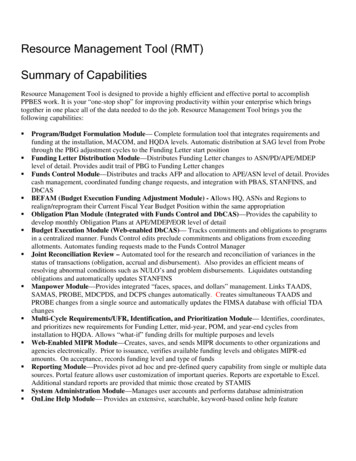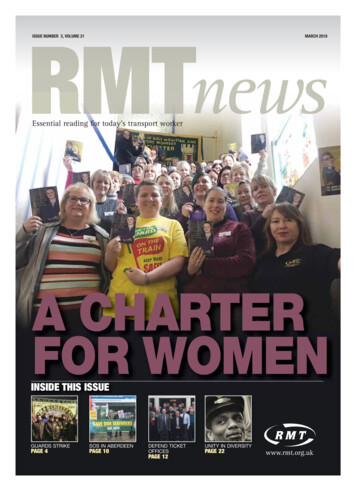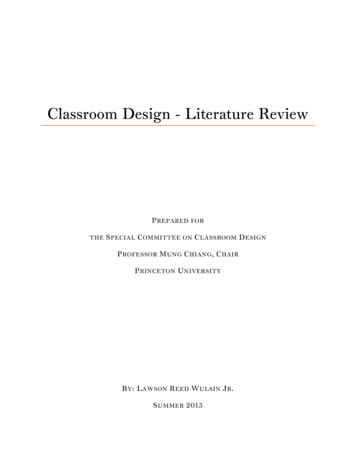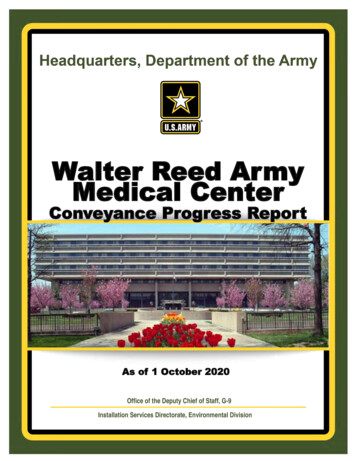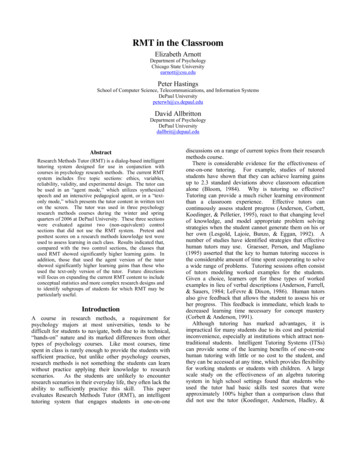
Transcription
RMT in the ClassroomElizabeth ArnottDepartment of PsychologyChicago State Universityearnott@csu.eduPeter HastingsSchool of Computer Science, Telecommunications, and Information SystemsDePaul Universitypeterwh@cs.depaul.eduDavid AllbrittonDepartment of PsychologyDePaul Universitydallbrit@depaul.eduAbstractResearch Methods Tutor (RMT) is a dialog-based intelligenttutoring system designed for use in conjunction withcourses in psychology research methods. The current RMTsystem includes five topic sections: ethics, variables,reliability, validity, and experimental design. The tutor canbe used in an “agent mode,” which utilizes synthesizedspeech and an interactive pedagogical agent, or in a “textonly mode,” which presents the tutor content in written texton the screen. The tutor was used in three psychologyresearch methods courses during the winter and springquarters of 2006 at DePaul University. These three sectionswere evaluated against two (non-equivalent) controlsections that did not use the RMT system. Pretest andposttest scores on a research methods knowledge test wereused to assess learning in each class. Results indicated that,compared with the two control sections, the classes thatused RMT showed significantly higher learning gains. Inaddition, those that used the agent version of the tutorshowed significantly higher learning gains than those whoused the text-only version of the tutor. Future directionswill focus on expanding the current RMT content to includeconceptual statistics and more complex research designs andto identify subgroups of students for which RMT may beparticularly useful.IntroductionA course in research methods, a requirement forpsychology majors at most universities, tends to bedifficult for students to navigate, both due to its technical,“hands-on” nature and its marked differences from othertypes of psychology courses. Like most courses, timespent in class is rarely enough to provide the students withsufficient practice, but unlike other psychology courses,research methods is not something the students can learnwithout practice applying their knowledge to researchscenarios.As the students are unlikely to encounterresearch scenarios in their everyday life, they often lack theability to sufficiently practice this skill. This paperevaluates Research Methods Tutor (RMT), an intelligenttutoring system that engages students in one-on-onediscussions on a range of current topics from their researchmethods course.There is considerable evidence for the effectiveness ofone-on-one tutoring. For example, studies of tutoredstudents have shown that they can achieve learning gainsup to 2.3 standard deviations above classroom educationalone (Bloom, 1984). Why is tutoring so effective?Tutoring can provide a much richer learning environmentthan a classroom experience.Effective tutors cancontinuously assess student progress (Anderson, Corbett,Koedinger, & Pelletier, 1995), react to that changing levelof knowledge, and model appropriate problem solvingstrategies when the student cannot generate them on his orher own (Lesgold, Lajoie, Bunzo, & Eggan, 1992). Anumber of studies have identified strategies that effectivehuman tutors may use. Graesser, Person, and Magliano(1995) asserted that the key to human tutoring success isthe considerable amount of time spent cooperating to solvea wide range of problems. Tutoring sessions often consistof tutors modeling worked examples for the students.Given a choice, learners opt for these types of workedexamples in lieu of verbal descriptions (Anderson, Farrell,& Sauers, 1984; LeFevre & Dixon, 1986). Human tutorsalso give feedback that allows the student to assess his orher progress. This feedback is immediate, which leads todecreased learning time necessary for concept mastery(Corbett & Anderson, 1991).Although tutoring has marked advantages, it isimpractical for many students due to its cost and potentialinconvenience, especially at institutions which attract nontraditional students. Intelligent Tutoring Systems (ITSs)can provide some of the learning benefits of one-on-onehuman tutoring with little or no cost to the student, andthey can be accessed at any time, which provides flexibilityfor working students or students with children. A largescale study on the effectiveness of an algebra tutoringsystem in high school settings found that students whoused the tutor had basic skills test scores that wereapproximately 100% higher than a comparison class thatdid not use the tutor (Koedinger, Anderson, Hadley, &
Figure 1. A Partial Dialog Advancer NetworkMark, 1997). Dialog-based ITS’s support natural languageinteraction with students and can allow students toexperience collaborative problem solving and feedbacksimilar to that provided by a human tutor. One dialogbased ITS, AutoTutor, has been shown to produce learninggains of up to one standard deviation above reading atextbook alone (Graesser, Jackson, Mathews, Mitchell,Olney, Ventura, Chipman, Franceschetti, Hu, Louwerse,Person, & TRG, 2003).Description of the RMT SystemResearch Methods Tutor (RMT) is a dialog-based tutor thataids students in learning concepts from psychologyresearch methods. With a similar tutoring style to that ofAutoTutor, RMT engages students in a question-andanswer dialog and evaluates answers by comparing them toa set of expected answers (Wiemer-Hastings, Graesser,Harter, & the Tutoring Research Group, 1998). RMT is aweb-based system, so students can use the tutor when it ismost convenient for them.The tutor’s behavior is controlled by a Dialog AdvancerNetwork (DAN). The DAN is a transition network whereeach arc is associated with conditions, actions, and outputs.A partial DAN is shown in Figure 2. The DAN allowsRMT to respond appropriately to many different types ofstudent inputs. Each path through the DAN starts bycategorizing the current student input, creates a response toit, and then creates a follow-up utterance to keep the dialogmoving. For example, if a student asks the tutor to repeatwhat he just said, the DAN recognizes the request, outputs“Once again,” and copies the previous tutor utterance. Ifthe student has just provided an answer to a question, theDAN will evaluate the answer, provide positive or negativefeedback as appropriate, and then present a follow-upprompt or hint, or, if the current question has beenthoroughly answered, a summary of the complete response.The DAN mechanism provides a measure of flexibility tothe RMT system. The behavior of the tutor can be alteredby simply modifying the network.As mentioned above, RMT evaluates student answers bycomparing them to a set of expected answers. Three majorcomponents are responsible for the comparison. The firstis an automatic spelling correction module. If any wordthat the student enters is not in RMT’s lexicon, then aspellis called to provide a set of possibilities. RMT selects themost likely respelling from its lexicon. The secondcomponent is a keyword matcher, which checks for literalsimilarity of strings. This is especially useful for theshorter answers. The third component is Latent SemanticAnalysis (LSA) (Landauer & Dumais, 1997). LSA createsa high-dimensional vector representation for each contentword from a corpus of domain-related texts. The vectorfor a student answer is created by combining the LSAvectors of the words in the answer. Vectors for expectedanswers are created in the same way. The cosine functionmeasures the similarity of the vectors.Currently RMT has five topic modules that correspondto traditional topics in introductory undergraduate researchmethods courses – ethics, variables, reliability, validity,and experimental design. Following Bloom’s taxonomy(1956), each topic contains a mix of conceptual, analytic,and synthetic questions.Conceptual questions aretraditional textbook questions with a single correct answer(for example, “What is the difference between validity andreliability?”). Analytic questions require the students toapply their conceptual knowledge to a particular scenario(for example, “What threats to validity may be a problemfor this study?”). Synthetic questions require a higher levelof understanding of the material that allows the students toconstruct an entire solution for a scenario (for example, “Iwant to know if frustration causes aggression, can youdesign an experiment to address this issue?”).In order to make comparisons between dialog-basedtutoring and a more textbook-style approach, the systemincludes two instruction conditions: a computer-aided
Figure 2. Mr. Joshua and the Basic RMT Interface (Tutor/Agent Mode).instruction (CAI) condition and a tutor condition. The CAIcondition consists of textbook-style passages ofinformation that are presented sequentially to the student.To ensure that the topic material was read, the studentanswers brief multiple choice questions about the topic. Inthe tutoring condition, RMT engages in a dialog with thestudent about the topic. The tutor asks the studentquestions, and the student types answers in a response box.RMT uses latent semantic analysis (LSA) to process thestudent answers and respond appropriately. If the studentanswers incorrectly, RMT avoids giving negative feedback(as expert human tutors often do – Person, 1994) andengages in a series of prompts and hints to help the studentarrive at the correct answer. Prompts are sentencecompletion items that can be answered with a short phrase(“Informed consent means that you obtain the participant’sconsent without .”). Hints are questions or statementsthat help the learner arrive at the correct answer bysoliciting a sentential answer to a smaller sub-question.After each question has been successfully navigated, RMTsummarizes the key elements of the problem and moves onto the next question.The tutor also has two presentation modes: a text-onlymode and an animated agent mode. The text-only modeconsists of a textual display of all of the questions,feedback, prompts, and hints, which the students read onscreen. The animated agent mode, in contrast, features amale “talking head” named “Mr. Joshua” (see Figure 1).At this time Mr. Joshua gestures in a number of humanlike ways, including turning, nodding, and shaking hishead (to indicate agreement or disagreement), gesturingwith his hands, raising his eyebrows, and blinking his eyes.The agent is implemented using Microsoft Agent softwareand “speaks” using a text-to-speech engine.Although the agent makes the system more visuallyappealing, the purpose of its inclusion is to assess anypotential increase in learning that an agent may provide.Some evidence suggests that an automated speaking agentmay aid learning by keeping the visual channels free forassessing other content. Consistent with Mayer’s (2001)cognitive theory of multimedia learning, Clark and Mayer,(2002) found that textual displays combined withadditional figures may visually overload the student and“short circuit” visual processing. In addition, Salvucci &Anderson (1998) suggested that learners pay little attentionto text presented on screen in intelligent tutoring settings.However, there is also evidence to suggest that an nimated,speaking agent may have negative affects on learning.When an animated agent is presented, the visual stimulusof the agent itself may distract the learner and bedisadvantageous to learning (Moreno, 2004). This effect isespecially problematic if the student is required to evaluatea visual stimulus onscreen while the agent is present.Although the current materials do not rely heavily onadditional graphics, a secondary goal of our research is todetermine whether the presence of an agent aids in learningin this particular intelligent tutoring situation.Method: Evaluating RMT in the ClassroomThe primary goal of the present study was to investigatethe effectiveness of RMT in the “real world,” i.e. not in alaboratory setting, but in combination with an actualcourse. We hypothesized that the classes that used RMTin conjunction with their traditional curriculum would
show larger learning increases than classes that did not useRMT. In addition, we investigated learning differencesbetween the dialog-based tutoring and textbook-based(CAI) conditions, as well as differences in agent and textpresentation modes.ParticipantsDuring the winter and spring of 2006, 136 participantswere included in the evaluation of RMT in the classroom.All participants were students enrolled in an introductoryundergraduate research methods course in psychology atDePaul University. Three of the course sections usedRMT as part of the course requirements, and two of thesections acted as non-equivalent control groups. Four ofthe five courses (two control and two RMT) were taught bythe same instructor, and the courses were evenly splitbetween daytime and evening sections. In total, there were83 participants in the RMT sections and 53 participants inthe control sections.Materials and DesignA 106-item multiple choice test was created for use as apre- and post-test. The test took approximately 1 hour tocomplete. Items were categorized according to the topic towhich they applied (ethics, variables, reliability, validity,or experimental design), with two questions correspondingto more than one topic. There were 20 ethics questions, 25variables questions, 20 reliability questions, 23 validityquestions, and 20 experimental design questions.The students were assigned according to theirenrollment in the RMT or non-RMT sections. Thusassignment to the RMT vs. baseline control condition wasbetween-subjects. In addition, students in the RMTcourses completed their RMT modules in one of twoinstruction conditions: the tutor condition or the CAIcontrol condition. Each RMT student saw two of thetopics in one condition and three of the topic in the othercondition. This allowed for comparison between not onlythe RMT and control participants across classes, but alsobetween the tutor and CAI conditions.Finally, students in all courses were asked to install therelevant software on their personal computers. RMTstudents who could not successfully install the software ona computer were assigned to the text-only presentationmode. All other RMT students were assigned to the agentpresentation mode. Thus, RMT students self-selected intothe agent or text-only presentation modes.ProcedureOn the first day of class, students in all evaluated sectionswere given the pretest. In order to ensure that the studentsdid not differ markedly in their ability to use computertechnology or their access to computers, all students weregiven RMT registration and installation instructions andwere asked to install the RMT software on their personalcomputers. Most students did so successfully (109 of the136 total students). As mentioned above, students in theRMT courses who could not install the software wereassigned to the text-only presentation mode. Throughoutthe quarter, the RMT students were assigned to completethe topic modules as the topics were covered in class. Onthe last day of classes students in all sections were asked tocomplete the 106-item posttest.Results: Evaluating RMT in the ClassroomThree primary questions were investigated: 1) Do classesthat use RMT show higher learning gains than nonequivalent control classes? 2) Are there differencesbetween instruction conditions (tutor vs. CAI) for theindividual topic modules? 3) Are there differencesbetween the agent and text-only presentation modes?If a student was unable to complete the posttest orpretest, his/her data was excluded from the analysis. Sixstudents were excluded from an RMT section because ofan incomplete pretest or posttest, and one student wasexcluded from a control section. After excluding theseparticipants, there were 77 participants in the RMTsections and 52 participants in the control sections.Our initial hypothesis was that the learning gains forclasses that used RMT would be higher overall thanlearning gains for classes that did not use RMT. Thishypothesis was confirmed using an ANCOVA with overallgain scores (percent correct on posttest minus percentcorrect on pretest) as the dependent variable, the pretestscore as the covariate, and class condition (RMT classversus control class) as the independent variable. Aspredicted, we found a significant difference between RMTcourses and non-RMT courses, F (1, 126) 15.154, p .01. The effect size corresponding to this difference was.71 standard deviations, which was calculated using theNational Reading Panel (NRP, 2000, p. 15) standardizedmean difference formula: (treatmentMean - controlMean) /(0.5 * (treatmentStdDev controlStdDev )). The etasquared was η² .11. Although we expected all classes toshow some gains (since they had been enrolled in therelevant course for a quarter), those who used the tutor had
s a significant difference at the .05 level.#Indicates a significant difference at the .05 level.Table 1. Mean Gain Scores by Instruction Condition for each Tutor Topic Module.an average gain of .105 (10.5 percentage points frompretest to posttest), and those who did not use the tutor hadan average gain of .03 (3 percentage points from pretest toposttest). This difference remained statistically significantwhen only the four sections taught by the same instructorwere analyzed, F (1, 98) 4.99, p .028, NRP effect size .46, η² .05.When we broke the data down by individual class wefound that two of the three classroom sections that usedRMT had higher overall gain scores than the controlsections. Using an ANCOVA with gain score as thedependent variable, pretest score as the covariate, andsection as the independent variable, there was a significantdifference overall among courses, F (4, 123) 10.852, p .01, η² .26. Two of three sections using RMT hadsignificantly higher gain scores than the sections that didnot use RMT.These two sections did not differsignificantly from one another, but did differ significantlyfrom the third RMT section. Similarly, the non-RMTclasses did not differ significantly from one another. Gainscores for RMT classes were .1263, .1550, and .0117.Gain scores for non-RMT classes were .0142 and .0476.Because the pretest/posttest was broken down intoquestions for each individual topic module, we were alsoable to investigate differences among instructionconditions for each topic.For each of the five RMTmodules, student gain scores were analyzed in anANCOVA with instructional condition (control classversus CAI mode versus tutor mode) as the betweensubjects factor and pretest score as the covariate.(Although each RMT student completed some modules intutor mode and some in CAI mode, instructional conditionwas manipulated between-subjects when considering eachmodule separately.) If a student in the control group hadcompleted any topics in a module, then that student's datawere excluded from the analysis of that module. Likewise,any RMT student who did not complete any topics for thatmodule was also excluded.There was a significant overall difference amonginstruction conditions for all of the modules except theethics module. For the other modules there was asignificant difference between tutor and control, and forvariables, validity, and experimental design there was alsoa significant difference between CAI and control.Although the means were in the predicted direction for alltopic modules but validity (tutor followed by CAI followedby control), there was not a significant difference betweentutor and CAI for any of the modules. Means by conditionfor each module are found in Table 1.Lastly, we tested the hypothesis that the agentpresentation mode would produce higher learning gainsthan the text-only presentation mode or the controlcondition. Using an ANCOVA with gain score as thedependent variable, pretest score as the covariate, andpresentation mode (agent versus text-only versus control)as the between-subjects factor, this hypothesis wassupported, F (2, 125) 9.924, p .01, η² .14. The agentcondition had a mean gain of .119, the text condition had amean gain of .06, and the control condition had a meangain of .03. Using LSD paired comparisons, the agentmode was associated with significantly higher gain scoresthan both text-only (MD .06, SE .029) and controlconditions (MD .09, SE .02). The text condition wasnot significantly different from the control condition. Thiseffect remained when only the four instructor-consistentsections were analyzed, F (2, 97) 4.543, p .013, η² .09. (For these sections, the agent condition had a meangain of .094, the text condition had a mean gain of .028,and the control condition had a mean gain of .03.)Implications and Future Directions for RMTFive courses at DePaul University were evaluated duringthe 2005-2006 academic year. Of these five courses, threeused the RMT system and two acted as non-equivalentcontrol groups. It was hypothesized that the use of RMTwould result in higher learning gains on the pretest/posttestmeasure. This hypothesis was confirmed, with RMTclasses achieving an average gain of .71 standarddeviations over the control classes. This result is close tothe 1 standard deviation gain obtained by students usingthe AutoTutor system during intensive lab-based tutoringsessions (Graesser, Jackson, Mathews, Mitchell, Olney,Ventura, Chipman, Franceschetti, Hu, Louwerse, Person,& TRG, 2003). As RMT was used in a naturalisticenvironment with students who all interacted with thematerial to some extent (all students – even those in thecontrol group – were enrolled in a research methodscourse), we believe that this gain is impressive evidence ofthe effectiveness of the system. Although the evidence for
the advantage of the system’s tutor version over the CAIversion was weaker, we believe that the overall evidencesupports the effectiveness of the system.In addition to evaluating the system itself, the resultsobtained from using RMT in the classroom have allowedus to investigate other issues in intelligent tutoring.Although students in this particular study self-selected intoa presentation mode condition, we believe that theadvantages seen in the agent condition provide evidencethat the presence of a tutoring agent may aid in the learningprocess in our particular situation. Given the mixed natureof the evidence for the effectiveness of animatedpedagogical agents (Morena, 2004), this initial findingprovides an interesting issue for further study, particularlyas we add more visual elements to the system. It ispossible that the advantages seen in the present study wereaffected by the presence of synthesized speech and fewadditional (non-agent) visual stimuli. This issue will be anavenue for future study.During the next phase of RMT development, we plan toadd topic modules that will aid students as they attempt tointegrate research methods and statistics.At mostuniversities, these courses are taught separately, and manystudents find it difficult to understand the close connectionbetween them. We are currently developing a conceptualstatistics module that will address the application ofstatistical methods to particular types of research design.We are also developing a module that addresses morecomplex research designs. In addition, we plan to addgraphical elements to RMT by creating graphics for ourcurrent content and forming a data description andgraphing module, which will help students to display theresults of their studies visually and understand the types ofgraphs that are appropriate under given conditions.In addition to integrating statistics and research designin the next generation of RMT, we also plan to addelements which will incorporate various tutoring styles.We plan to augment our current dialog-based tutor withtable-style problems which require the student to solve aparticular design problem in steps. As the student answerseach question, he/she will begin “filling out” the table andcan see his/her progress through the problem.As RMT continues to develop, we are encouraged byour classroom results, and believe that RMT can be ofvalue, not only in investigating the effectiveness ofintelligent tutoring strategies and design features, but alsoin aiding students as they navigate more difficult researchdesign and statistical issues.ReferencesAnderson, J. R., Corbett, A. T., Koedinger, K. R., &Pelletier R. (1995). Cognitive tutors: Lessons learned. TheJournal of the Learning Sciences, 4, 2, 167-207.Anderson, J. R., Farrell, R., & Sauers, R. (1984). Howsubject matter knowledge affects recall and interest.American Educational Research Journal, 31, 313-337.Bloom, B. S. (1956). Taxonomy of educational objectives:The classification of educational goals. Essex, England:Longman Group Limited.Bloom, B.S. (1984). The 2 sigma problem: The search formethods of group instruction as effective as one-to-onetutoring. Educational Researcher, 13, 4-16.Clark, R., & Mayer, R. (2002). e-Learning and the Scienceof Instruction: Proven Guidelines for Consumers andDesigners of Multimedia Learning. Pfeiffer.Corbett, A. T., & Anderson, J. R. (1991). Feedback controland learning to program with the CMU LISP tutor. Paperpresented at the annual meeting of the AmericanEducational Research Association, Chicago, IL.Graesser, A.C., Person, N. K., & Magliano, J. P. (1995).Collaborative dialog patterns in naturalistic one-on-onetutoring. Applied Cognitive Psychology, 9, 359–387.Graesser, A. C., Jackson, G.T., Mathews, E.C., Mitchell,H.H., Olney, A., Ventura, M., Chipman, P., Franceschetti,D., Hu, X., Louwerse, M. M., Person, N. K., & theTutoring Research Group. (2003). Why/AutoTutor: A testof learning gains from a physics tutor with naturallanguage dialog. In Proceedings of the 25th AnnualConference of the Cognitive Science Society. Mahwah, NJ.Koedinger, K. R., Anderson, J.R., Hadley, W.H., & Mark,M. A. (1997). Intelligent tutoring goes to school in the bigcity. International Journal of Artificial Intelligence inEducation, 8, 30-43.Landauer, T. K., & Dumais, S. T. (1997). A solution toPlato’s problem: The latent semantic analysis theory ofacquisition, induction, and representation of knowledge.Psychological Review, 104, 211–240.LeFevre, J. A., & Dixon, P. (1986).Do writteninstructions need examples? Cognition and Instruction, 3,1-30.Lesgold, A., Lajoie, S., Bunzo, M., & Eggan, G. (1992).Sherlock: A coached practice environment for anelectronics troubleshooting job. In J. Larkin and R.Chabay, (Eds.), Computer Assisted Instruction andIntelligent Tutoring Systems: Shared Goals andComplementary Approaches, 201-238.Hillsdale:Lawrence Erlbaum Associates.Mayer, R. E. (2001). Multimedia learning. Cambridge,England: Cambridge University Press.Moreno, R. (2004). Animated pedagogical agents ineducational technology. Educational Technology, 44, 6,23-30.National Reading Panel. (2000). Teaching children toread: An evidence-based assessment of the scientificresearch literature on reading and its implications forreading instruction, Reports of the Subgroups. (NIHPublication No. 00-4754). Washington, DC: NationalInstitute of Child Health & Human Development.
Person, N. K. (1994). An analysis of the examples thattutors generate during naturalistic one-to-one tutoringsessions. Dissertation Abstracts International: Section B:The Sciences and Engineering, 55, 10-B, 4628.Salvucci, D., & Anderson, J. R. (1998). Tracing eyemovement protocols with cognitive process models. InProceedings of the Twelfth Annual Conference of theCognitive Science Society, 923-928. Hillsdale: LawrenceErlbaum Associates.Wiemer-Hastings, P., Graesser, A., Harter, D., & theTutoring Research Group. (1998). The foundations andarchitecture of AutoTutor. Proceedings of the 4thInternational Conference on Intelligent Tutoring Systems,334–343. Berlin: Springer.
DePaul University peterwh@cs.depaul.edu David Allbritton Department of Psychology DePaul University dallbrit@depaul.edu Abstract Research Methods Tutor (RMT) is a dialog-based intelligent tutoring system designed for use in conjunction with courses in psychology research methods. The current RMT system includes five topic sections: ethics .




